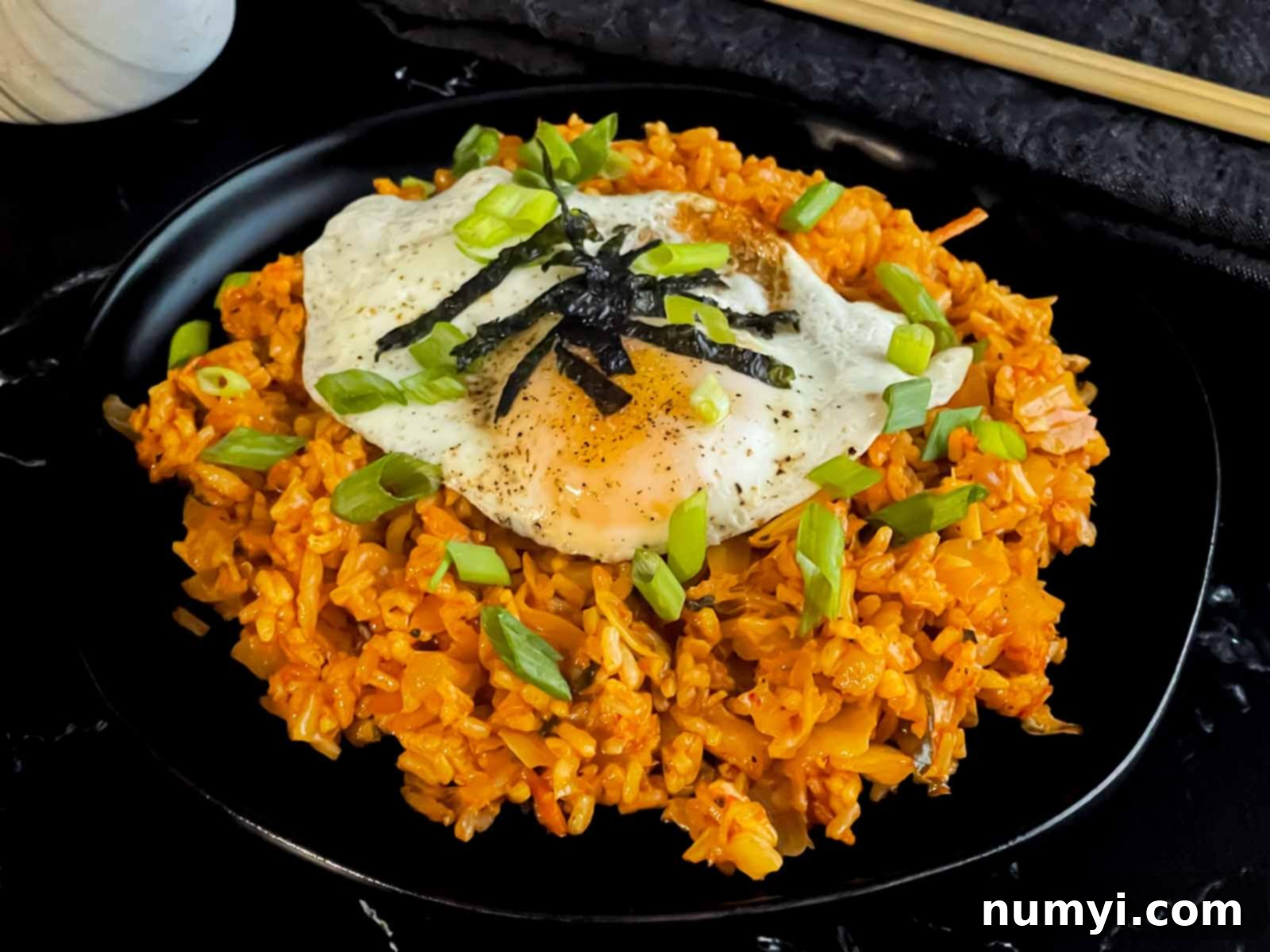The Ultimate Guide to Making Flavorful Kimchi Fried Rice (Kimchi-bokkeumbap) at Home
If you’ve never had kimchi fried rice before, prepare to embark on a truly delightful culinary journey. This iconic Korean dish, known as Kimchi-bokkeumbap, is an explosion of savory, spicy, and tangy flavors, surprisingly easy to prepare, and incredibly versatile. Whether you serve it as a hearty main course or a vibrant side dish, it’s guaranteed to impress. Its simplicity belies its profound depth of taste, making it a must-try for any food enthusiast.
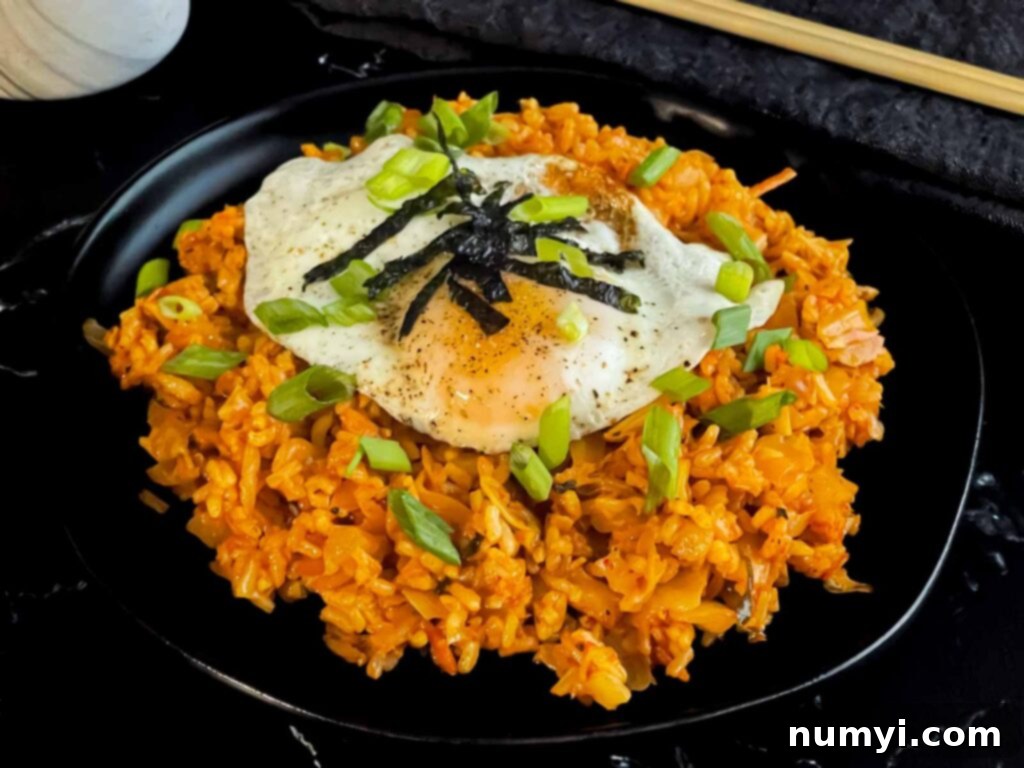
Why You Will Love This Kimchi Fried Rice Recipe
We’ve said it before, and we’ll enthusiastically say it again: a truly great recipe is both simple to execute and incredibly delicious. This Kimchi Fried Rice recipe embodies that philosophy perfectly. You won’t need any obscure, hard-to-find ingredients to create a dish that tastes profoundly authentic and satisfying. It’s the ideal blend of comfort food and bold Korean flavors, making it suitable for both novice cooks and seasoned culinary enthusiasts.
One of the beauties of this recipe is its adaptability. We’ve included pork to add a savory depth, but you can easily customize it with your favorite protein, or even keep it entirely vegetarian. The rich, spicy, and tangy notes of the fermented kimchi provide a wonderful contrast to the soft, fluffy texture of the rice. As the kimchi cooks, it softens slightly while still offering a delightful crunch, creating a dynamic textural experience in every spoonful. Visually, the vibrant red and orange hues imparted by the kimchi and gochujang are absolutely stunning, making it a feast for the eyes as well as the palate.
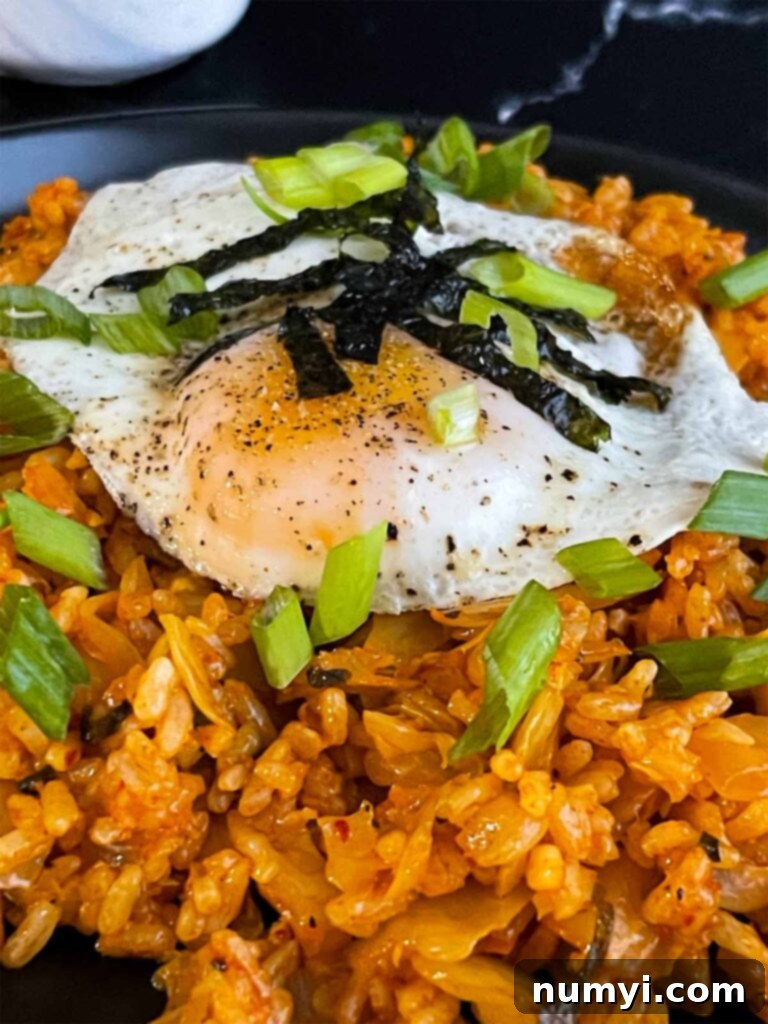
The bottom line is, you’re going to achieve a restaurant-quality dish in under 30 minutes, all while enjoying the satisfaction of homemade cooking and saving a significant amount compared to eating out. This is a culinary triple win: quick, affordable, and irresistibly delicious. Get ready to add this incredible Kimchi Fried Rice to your regular meal rotation!
What Exactly Is Kimchi? A Deeper Dive
Kimchi is much more than just a side dish; it’s a culinary cornerstone of Korean cuisine and a vibrant symbol of Korean culture. At its heart, kimchi is a traditional Korean preparation of fermented vegetables, most commonly napa cabbage and Korean radish. The vegetables are meticulously seasoned with a potent mixture that typically includes chili powder (gochugaru), garlic, ginger, green onions, and sometimes salted seafood products like *saeujeot* (fermented shrimp). This careful fermentation process yields its signature spicy, tangy, umami-rich, and slightly sour flavor profile – a taste that many find utterly addictive.
In Korea, kimchi is truly ubiquitous. It serves as an essential accompaniment to nearly every meal, providing a refreshing counterpoint to richer dishes. Beyond the table, it’s a versatile ingredient used in countless recipes, from stews and soups to pancakes and, of course, fried rice. The fermentation not only preserves the vegetables but also transforms them, creating beneficial probiotics that are excellent for gut health. This nutritional powerhouse is packed with vitamins A, B, and C, and contributes significantly to a robust immune system and healthy digestion.

There are literally hundreds of different types of kimchi, each varying by region, seasonal ingredients, and family recipes. From the classic *baechu kimchi* (napa cabbage kimchi) to *kkakdugi* (diced radish kimchi) and refreshing *nabak kimchi* (water kimchi), there’s a wide spectrum of flavors and textures to explore. You can typically find various kinds of kimchi at your local Asian grocery store or even in larger supermarkets. Don’t be shy about trying it – whether you prefer a fiery kick or a milder tang, there’s a kimchi out there for you, and it will undoubtedly elevate your cooking to new and exciting levels.
Essential Ingredients for Kimchi Fried Rice
Crafting the perfect Kimchi Fried Rice starts with selecting the right ingredients. For a precise breakdown of quantities and their measurements, please refer to the detailed recipe card provided below. Our recipe incorporates 5 ounces of pork, for which we recommend using a single diced pork chop to achieve a wonderfully savory element. However, this dish is incredibly flexible. Should you wish to omit the pork, or perhaps substitute it with another protein, feel free to do so. For more creative ideas and dietary adjustments, don’t forget to explore the Variations section further down the page.
Key ingredients include day-old cooked rice, which is crucial for achieving the ideal fried rice texture – preventing it from becoming mushy. You’ll also need a generous amount of ripe kimchi and its flavorful juice, which contribute the signature tangy and spicy profile. Gochujang, a Korean chili paste, is essential for its unique blend of sweet, savory, and spicy notes, while dark soy sauce adds depth of color and a richer umami flavor. Fresh aromatics like onion, garlic, and ginger form the flavorful base, complemented by green onions for freshness and a touch of sesame oil for its distinctive nutty aroma. Having all your ingredients prepped and ready to go before you start cooking (known as *mise en place*) will make the cooking process smooth and enjoyable, ensuring a perfect fried rice every time.
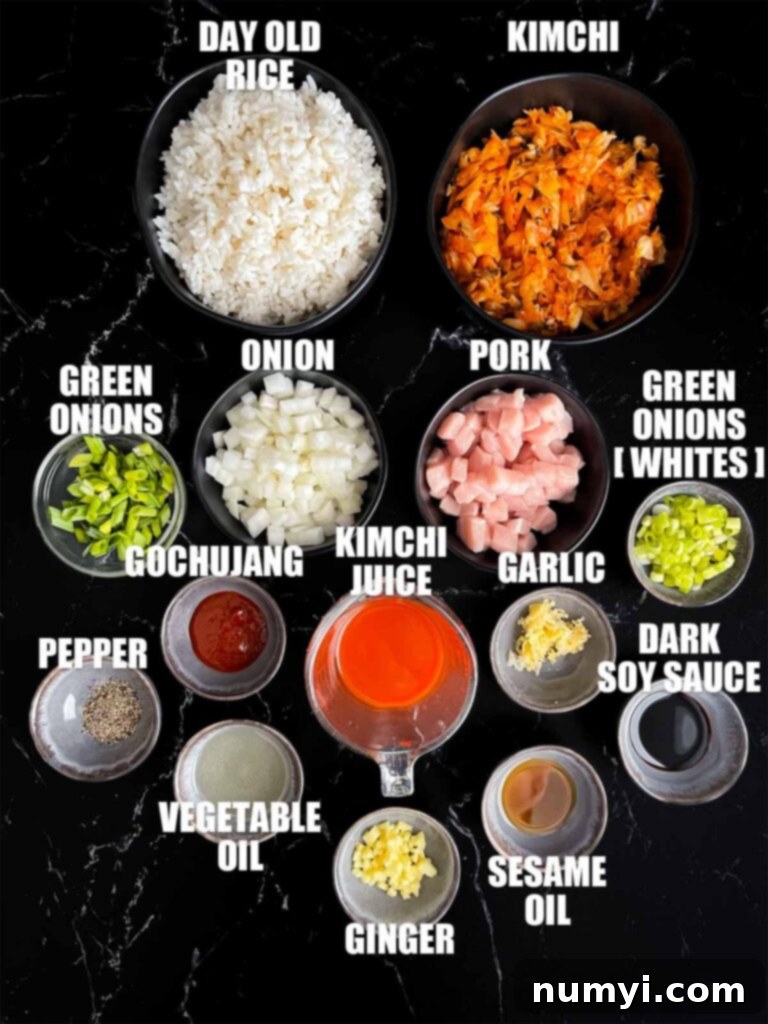
Step-by-Step: How To Make Kimchi Fried Rice
Creating this delicious Kimchi Fried Rice is a straightforward process, designed for efficiency and maximum flavor. Follow these simple steps for a perfect meal:
Begin by adding one tablespoon of a neutral cooking oil, such as canola, avocado, or vegetable oil, to a large skillet. Place the skillet over medium-high heat. The goal here is to get the oil shimmering, indicating it’s hot enough to start cooking effectively without smoking.
Once the oil is shimmering, carefully add the diced onion, the white parts of your green onions (which require slightly longer cooking), and your diced pork to the hot skillet. Stir everything together and cook for approximately 3 minutes. During this time, the onions will begin to soften and take on a slightly lighter, more translucent appearance, and the pork will start to brown, developing a savory crust.
Next, introduce the minced garlic and ginger to the skillet. Stir these aromatics thoroughly to combine them with the other ingredients. Continue cooking for an additional two to three minutes. You’ll notice the onions becoming fully translucent and wonderfully softened, and the potent fragrances of garlic and ginger will fill your kitchen, laying a foundational layer of flavor for your fried rice.
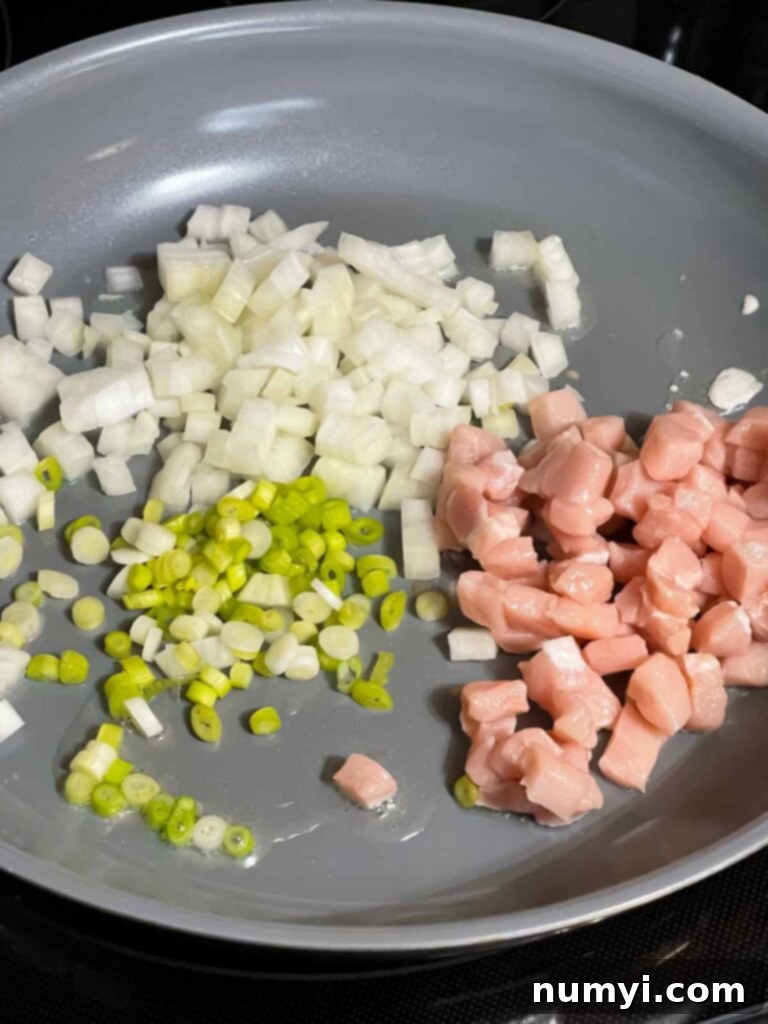
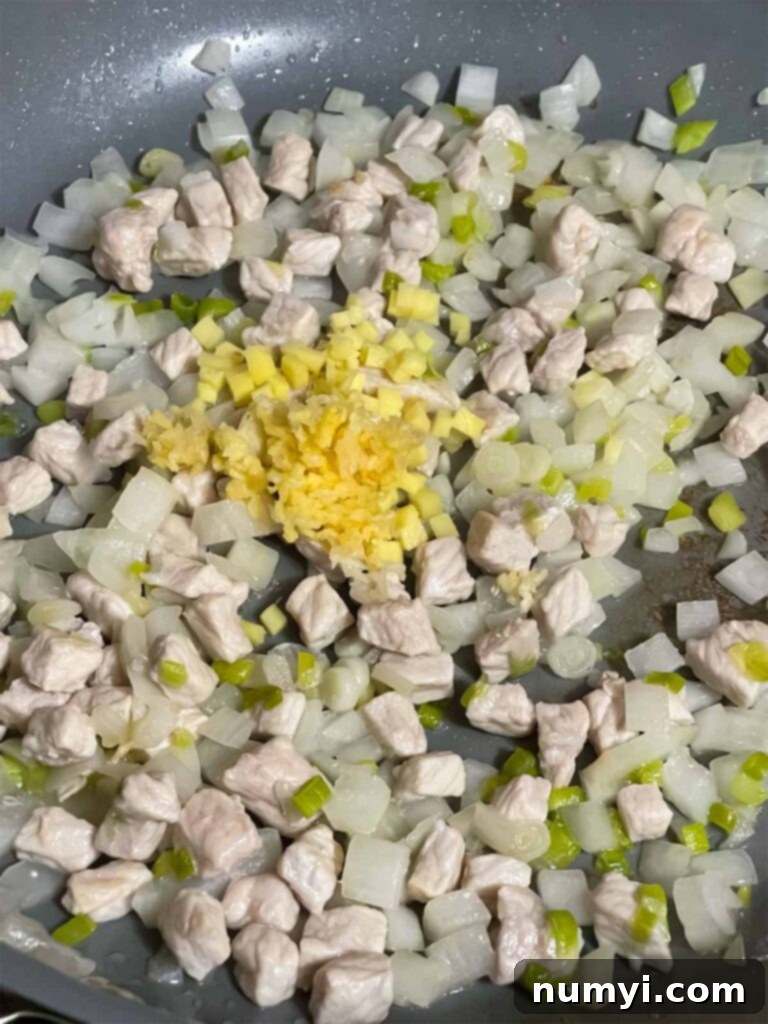
Now, it’s time to add the stars of the show: the chopped kimchi, the flavorful kimchi juice, a generous dollop of gochujang for that signature Korean spice, dark soy sauce for color and depth, and a dash of black pepper. Mix everything well and cook this vibrant mixture until the kimchi softens further, becoming tender and somewhat translucent. This usually takes about two minutes, allowing the flavors to meld beautifully.
Reduce the heat to medium-low, then incorporate your day-old cooked rice into the skillet. Stir diligently to ensure that the rice is thoroughly coated with the delicious kimchi mixture and that all the rich juices are absorbed. This step takes about 3 minutes, giving the rice time to soak up all the fantastic flavors and achieve a uniform reddish hue.
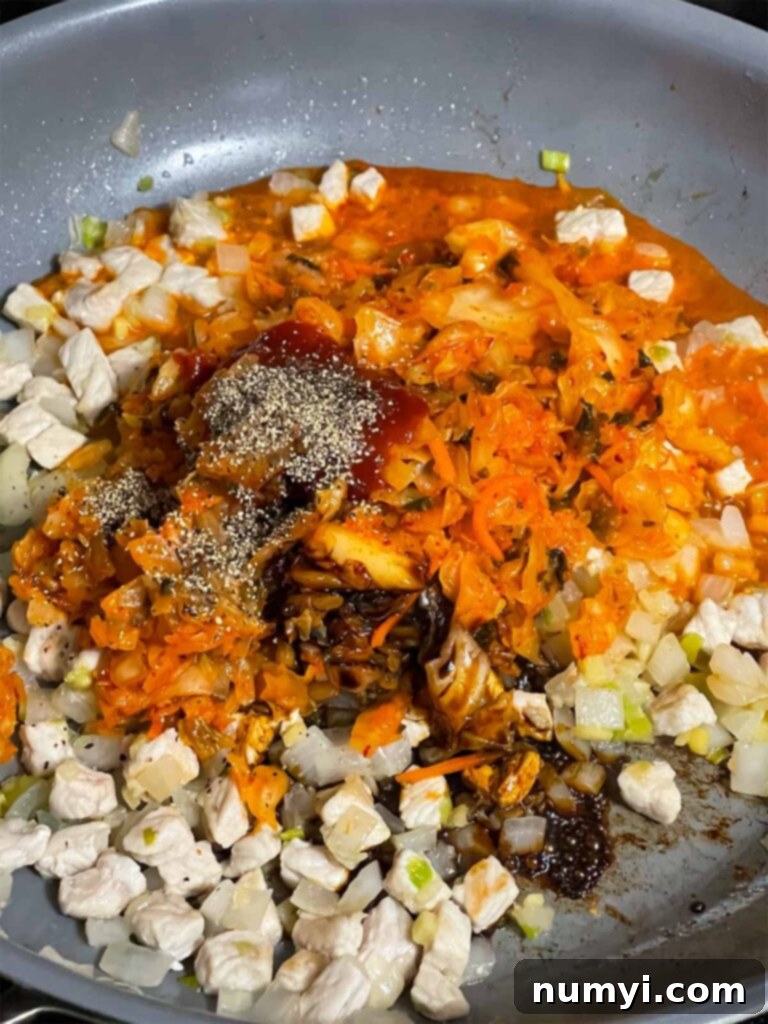
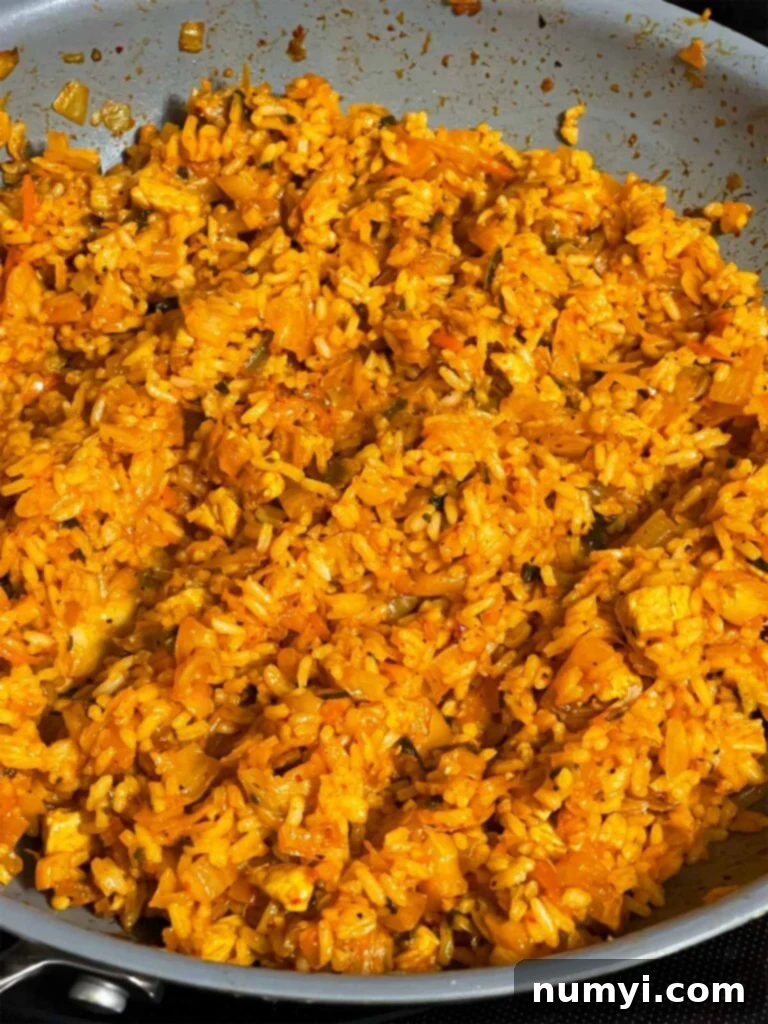
To achieve that desirable crispy texture characteristic of excellent fried rice, add another tablespoon of neutral oil along with the sesame oil to the skillet. Increase the heat back to medium-high. Cook, stirring occasionally to prevent burning but allowing the rice to sit untouched for short intervals. This process encourages the rice to develop a slight crust at the bottom of the pan, adding a wonderful textural contrast. Continue for about 4 to 5 minutes, until the rice starts to stick pleasingly.
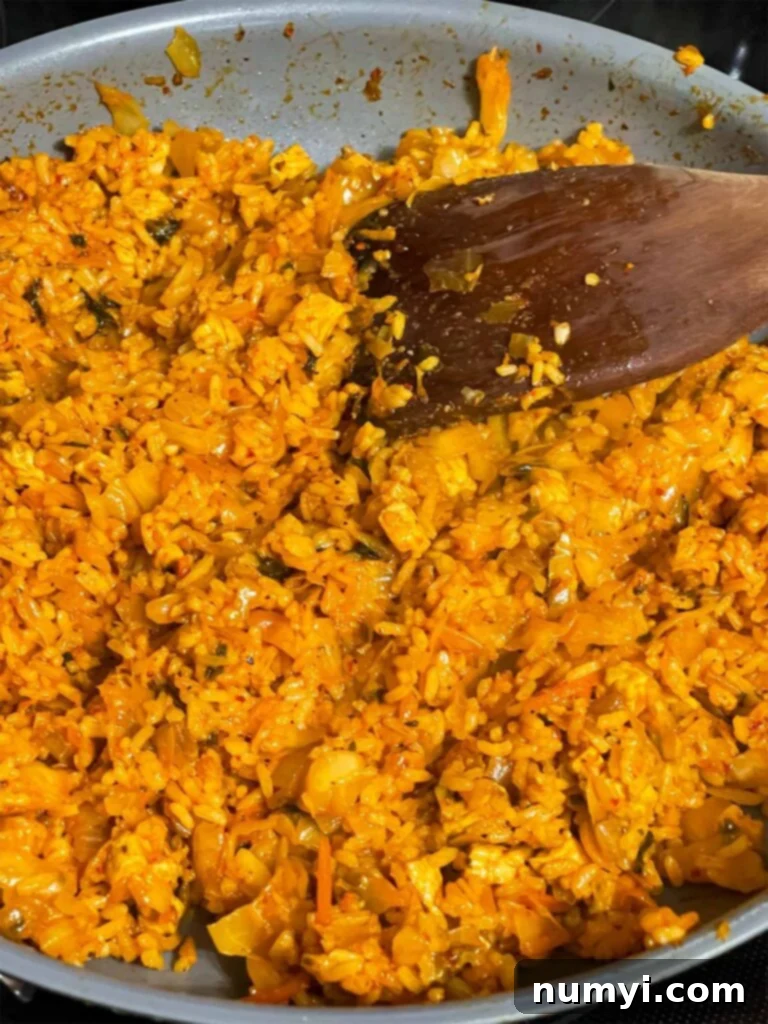
Finally, remove the skillet from the heat. Your delicious Kimchi Fried Rice is ready! Garnish generously with the reserved green onions for a fresh, pungent bite. For an extra layer of richness and flavor, consider adding an optional fried egg (over easy is highly recommended) and some crumbled gim (roasted seaweed), which provides a delightful umami crunch. Serve immediately and savor the incredible flavors.
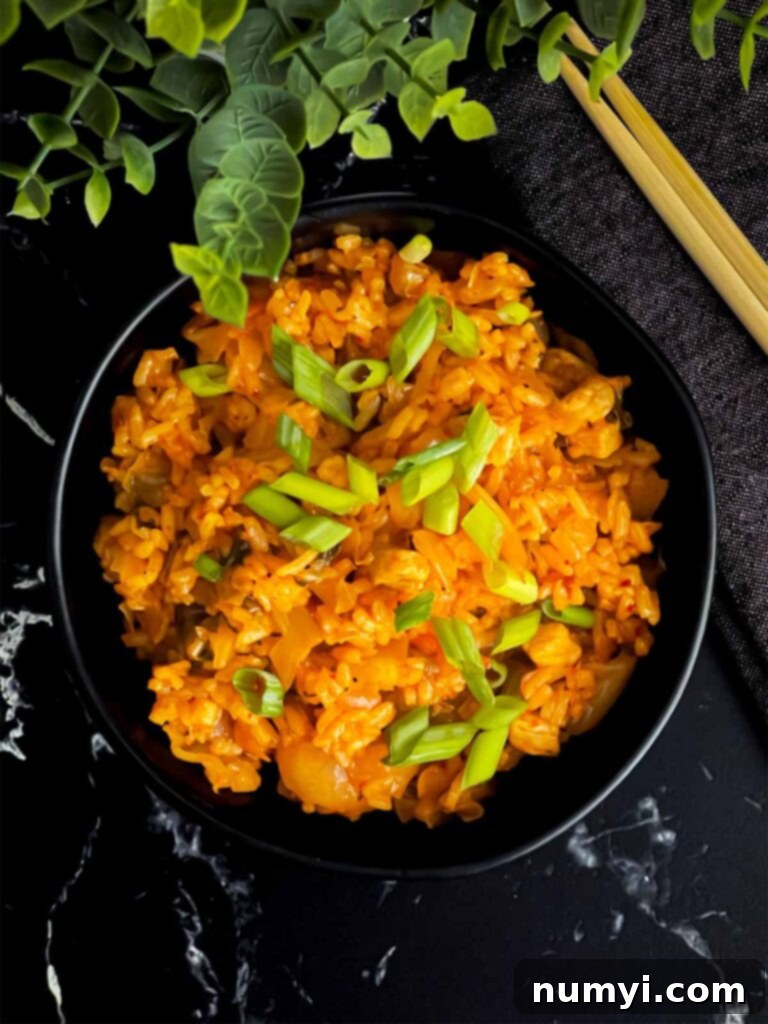
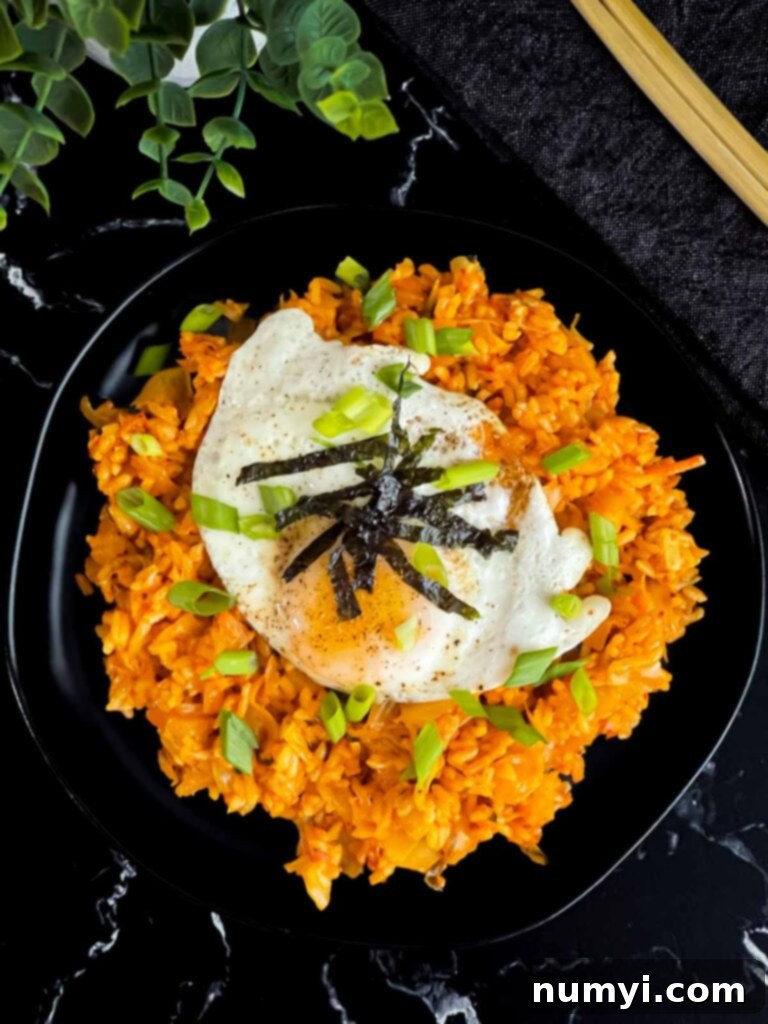
After experiencing this recipe, you’ll find it challenging to discover a dish that offers such an exceptional balance of taste, value, and effort. This Kimchi Fried Rice transcends the ordinary fried rice with its vibrant ingredients and complex flavor profile, moving it into a league of its own. It’s truly a next-level dish that will become a cherished part of your culinary repertoire.
Expert Tips for Perfect Kimchi Fried Rice
Achieving restaurant-quality kimchi fried rice at home is entirely possible with a few key techniques. Here are some expert tips to elevate your dish:
Day-Old Rice is King: This isn’t just a suggestion, it’s a golden rule for superior fried rice. Freshly cooked rice retains too much moisture, which can lead to a mushy, clumpy texture when stir-fried. Day-old rice, or even rice that has been refrigerated for a few hours, loses much of its moisture content, allowing the grains to separate beautifully and achieve that desired slightly crispy, chewy texture that is the hallmark of great fried rice. If you’re in a pinch, you can spread freshly cooked rice thinly on a baking sheet and refrigerate it for at least 30 minutes to help dry it out.
Master the Heat Levels: Kimchi and gochujang naturally bring a certain level of spice. To control the overall heat of your dish, start with a smaller amount of gochujang than recommended if you prefer a milder flavor. You can always add more to taste towards the end of cooking. Conversely, for a bolder kick, don’t hesitate to increase the gochujang or add a pinch of gochugaru (Korean chili flakes) for extra heat without significantly altering the paste’s unique sweet-savory notes.
“Mise en Place” – Prep First: Fried rice cooks incredibly quickly, requiring constant attention and rapid additions. To avoid a chaotic cooking experience and ensure everything cooks evenly, have all your ingredients prepped, measured, and ready to go *before* you even turn on the stove. This means chopping your onions, mincing garlic and ginger, dicing your pork, and having your kimchi and sauces within arm’s reach. This professional culinary technique will make the cooking process smooth, enjoyable, and virtually stress-free.
Embrace High Heat: For truly exceptional fried rice, you need high heat. Cooking on high heat helps to quickly evaporate any residual moisture, preventing the rice from steaming and becoming soft. More importantly, it allows the rice grains to make direct contact with the hot skillet, initiating the Maillard reaction. This caramelization creates those coveted crispy, slightly browned edges on the rice, enhancing both texture and flavor, giving your kimchi fried rice that irresistible smoky wok-fried taste.
Delicious Variations to Customize Your Kimchi Fried Rice
One of the many wonderful aspects of Kimchi Fried Rice is its incredible adaptability. Don’t be afraid to get creative and tailor it to your preferences or what you have on hand. Here are some fantastic variations to try:
Vegetarian and Vegan Versions: Easily transform this recipe by swapping out the pork. For a delicious vegetarian option, hearty mushrooms (like shiitake or cremini) or firm tofu are excellent choices. If using tofu, remember to press it thoroughly to remove excess water before dicing and pan-frying until golden for the best texture. For a fully vegan dish, ensure your chosen kimchi is vegan-friendly (some traditional kimchis contain *saeujeot* or fish sauce). You can often find vegan kimchi at Asian markets or health food stores.
Explore Different Proteins: While pork is classic, almost any protein works wonderfully here. Diced chicken breast or thigh, thinly sliced beef (marinated for extra tenderness), or quick-cooking shrimp can be fantastic additions. Even shredded leftover rotisserie chicken can be incorporated for an even faster meal. Simply cook your chosen protein thoroughly before adding the aromatics.
Boost with Extra Veggies: Want to add more nutrients and color? Kimchi fried rice is a perfect canvas for a variety of vegetables. Bell peppers (red, yellow, or orange for sweetness), frozen peas and carrots (added towards the end), finely chopped spinach or kale (wilts quickly), or even corn can be stirred in to make your dish even more wholesome and vibrant.
Adjust Kimchi Type and Spice Level: Kimchi itself comes in a wide range of spice levels and fermentation stages. If you’re sensitive to heat, look for milder kimchi varieties or those labeled “less spicy.” Conversely, if you crave more fire, opt for a spicier kimchi or add extra gochugaru (Korean chili flakes) directly to the pan. The age of kimchi also matters: older, more fermented kimchi will yield a deeper, tangier, and often spicier flavor than younger, fresher kimchi.
Indulge in Cheese Kimchi Fried Rice: For a truly comforting and indulgent twist, transform your kimchi fried rice into a cheesy delight. Once the rice is fully cooked in the skillet, simply sprinkle your favorite shredded cheese (cheddar, mozzarella, or a blend work well) on top and cover the pan for a minute or two, allowing the cheese to melt into a gooey layer. My personal favorite hack? Take a portion of this cheesy kimchi fried rice, add a slice of American cheese, and wrap it in a warm tortilla. It creates an unbelievably satisfying, spicy, and cheesy burrito – truly fantastic!
Frequently Asked Questions (FAQ’s) About Kimchi Fried Rice
While you technically *can* use freshly cooked rice, it’s highly recommended to use day-old rice for the best results. Freshly cooked rice has a higher moisture content, which can make your fried rice mushy and clumpy, rather than achieving those distinct, slightly crispy grains. If you’re in a rush and only have fresh rice, a quick trick is to spread it out thinly on a large baking sheet or tray. Allow it to cool down to room temperature, then place it in the fridge for at least 30 minutes. This helps to dry out the surface of the rice, mimicking the texture of day-old rice and preventing stickiness in the pan.
Gochujang (Korean chili paste) offers a unique balance of spicy, savory, and subtly sweet flavors, along with a thick, glossy texture. Finding an exact substitute can be challenging, but a combination of sriracha and miso paste comes quite close. Sriracha provides the necessary heat and some tang, while miso paste contributes the deep umami and savory notes. Start with about half the amount of gochujang specified in the recipe for sriracha, and add miso paste to taste, aiming for a similar consistency and depth of flavor. You might also add a tiny pinch of sugar if your sriracha and miso combination lacks the slight sweetness of gochujang.
Absolutely, making this dish vegan is quite simple and yields equally delicious results! The main steps involve replacing the pork and ensuring your kimchi is vegan-friendly. For the protein, pressed and diced tofu, a variety of mushrooms (like shiitake, oyster, or cremini), or even tempeh would make excellent substitutes. For the kimchi, be aware that traditional recipes often include *saeujeot* (fermented shrimp) or fish sauce for umami. However, many brands now offer vegan kimchi, typically found in Asian markets or the refrigerated section of larger grocery stores. Always check the ingredient label to confirm. To enhance the umami in a vegan version, you can also add a touch of mushroom powder or extra soy sauce.
Other Delicious Rice Dishes to Explore
If you love the versatility and comforting nature of rice, there’s a whole world of incredible rice dishes waiting to be discovered. From hearty mains to flavorful sides, rice provides an excellent foundation for diverse culinary creations. Once you’ve mastered this Kimchi Fried Rice, consider expanding your repertoire with these other tantalizing options:
How to Make Cajun Dirty Rice
Basmati Rice Risotto (Stick Of Butter Rice)
Cilantro Lime Rice
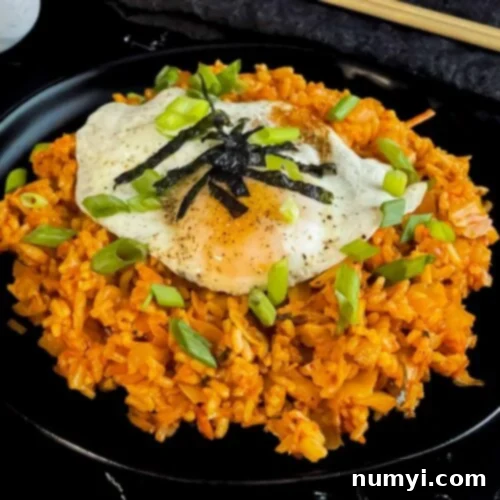
Kimchi Fried Rice (Kimchi-bokkeumbap) Recipe
Print
Pin
Rate
Ingredients
- 5 oz Pork diced
- 3 cups Rice cooked, day old.
- 1 1/4 cup Kimchi Sliced
- 1/4 cup Kimchi juice juiced from kimchi
- 2 tbsp Vegetable oil divided, 1 tbsp each
- 1/4 cup Water
- 1 cup Onion diced
- 2 tsp Ginger minced
- 2 cloves Garlic minced
- 6 Green onions White and green separated, whites sliced thinly, greens sliced for garnish
- 1 tbsp Gochujang
- 1 tbsp Dark soy sauce
- 1 tsp Black pepper
- 1 tbsp Sesame Oil
Optional Garnish
- Eggs over easy
- Sesame seeds
- Green onions
- Gim (roasted seaweed)
Instructions
-
Add 1 tbsp of vegetable oil to a large skillet over medium high heat.2 tbsp Vegetable oil
-
Once shimmering, add the onion, the whites of the green onion, and the pork to the skillet. Cook for a 3 minutes until the onions just start to lighten up.1 cup Onion, 6 Green onions, 5 oz Pork
-
Add the garlic and ginger to the skillet, cooking for an additional 2 to 3 minutes until the onions are translucent and softened.2 tsp Ginger, 2 cloves Garlic
-
Add the kimchi, kimchi juice, water, gochujang, soy sauce, and black pepper. Cook until the kimchi becomes softened and translucent. About 4-5 minutes.1 1/4 cup Kimchi, 1/4 cup Kimchi juice, 1/4 cup Water, 1 tbsp Gochujang, 1 tsp Black pepper, 1 tbsp Dark soy sauce
-
Reduce the heat to medium low and add the rice. Mix to combine well and allow all the juices to be absorbed by the rice. About 5-7 minutes.3 cups Rice
-
Add another tbsp of vegetable oil and the sesame oil and increase the heat to medium high. When the rice starts to stick a bit, it’s ready to be served. About 4 to 5 minutes.1 tbsp Sesame Oil, 2 tbsp Vegetable oil
-
Remove, garnish and serve.
Optional Garnish
-
Top with sesame seeds, green onion, gim, and a fried egg.Eggs, Sesame seeds, 6 Green onions
Notes
Store leftover kimchi fried rice in an airtight container in the fridge for up to 3 days. Reheat in a skillet over medium heat or in the microwave until hot.
